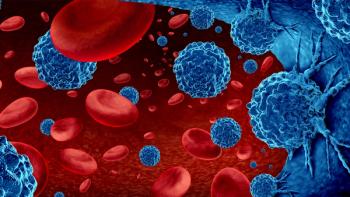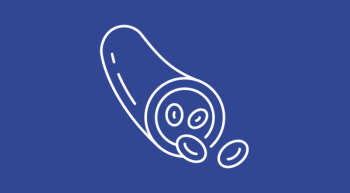
Avasopasem Manganese Significantly Reduces IMRT-Induced Severe Oral Mucositis, Is Feasible in Clinical Workflow
Elizabeth R. Cullen, MSN, ARNP, highlights the efficacy of avasopasem manganese in mitigating severe oral mucositis in patients with locally advanced head and neck cancer.
Avasopasem manganese (GC4419) significantly reduced the incidence of severe oral mucositis (SOM) associated with standard-of-care (SOC) intensity-modulated radiation therapy (IMRT) vs placebo for patients with locally advanced head and neck cancer, according to findings from the phase 3 ROMAN trial (NCT03689712). The findings were presented in tandem with a discussion on implementing the administration of the agent into radiation clinical workflow at the 48th Annual Oncology Nursing Society Congress.1
Through IMRT, 54% of patients (n = 241) who received avasopasem manganese experienced SOM compared with 64% of patients (n = 166) who received placebo for a 16% reduction (relative risk [RR], 0.84; P = .045). This was observed at all radiation therapy landmarks and after treatment.
“Avasopasem [manganese] demonstrated statistically significant and clinically meaningful reductions in SOM across key parameters of patient burden,” Elizabeth R. Cullen, MSN, ARNP, an advanced registered nurse practitioner at the University of Iowa Hospitals & Clinics, said in a presentation of the data. “Approximately, 70% of patients who receive SOC [IMRT] will develop SOM. We categorized severe as a grade 3 or a grade 4, with grade 3 [comprising] mucosal ulcerations and [the inability] to eat a solid diet. Grade 4 [SOM] is mucosal ulcerations and [inability for the patient] to eat a liquid or a solid diet. If you work with head and neck cancer patients, you know that this treatment course is particularly grueling.”
In addition to meeting the primary end point of the study, a 56% reduction in days of SOM was observed with a median of 8 days in the avasopasem manganese arm compared with a median of 18 days in the placebo arm (P = .002). Grade 4 SOM occurred in 24% of patients in the experimental arm vs 33% of patients in the placebo arm for a 27% reduction between treatments (P = .052). Finally, a 29% decrease was observed in delaying the onset of first SOM events among patients; in the avasopasem manganese arm the median days to onset was 49 days vs 38 days in the placebo arm (P = .002).1,2
Patients enrolled to ROMAN were randomly assigned 3:2 to avasopasem manganese at 90 mg or placebo followed by SOC IMRT and cisplatin for 7 weeks.1,2 The primary end point was incidence of SOM through IMRT treatment and secondary end points included duration of SOM, incidence and total number of days of grade 4 SOM, safety, renal function, and tumor outcomes.1,2
Baseline characteristics were similar between the avasopasem manganese and placebo arms. Most patients had oropharyngeal cancer (80% and 85%, respectively); were HPV-positive (80% and 81%); and were receiving IMRT as definitive treatment (81% and 81%). Five or more normal mucosal sites (≥ 50 Gy) were reported among 48% of patients in the investigative arm compared with 48% of patients in the placebo arm. Three or 4 sites were reported in 49% and 45% of patients in the avasopasem manganese and placebo arms, respectively.1,2 “There was a large area of mucosa that could be affected by the radiation,” Cullen said.
“As far as treatment adherence goes, [patients in] both the intervention and placebo group completed therapy as prescribed,” she added. “So, avasopasem manganese did not limit the ability to complete treatment.” One dose reduction was reported for 10% of patients in the avasopasem manganese arm compared with 5% in the placebo arm.1,2
Reduction in the use of narcotics and feeding tube usage were also reported with avasopasem manganese. “Although the study was not originally looking for these outcomes, there were a nominal decrease in both the use of narcotics by patients going through treatment and also in patients that required feeding tubes,” Cullen said.
Specifically, a 13% reduction in usage of narcotics after the start of radiation therapy was observed with avasopasem manganese vs placebo (48% vs 55%, respectively). Additionally, 35% of patients receiving avasopasem manganese used narcotics for SOM pain vs 40% receiving placebo. In terms of feeding tubes, 21% of patients in the experimental arm required a gastronomy tube after the start of radiation vs 26% in the placebo arm and overall, 48% of patients required a gastronomy tube compared with 61%, respectively.1,2
“With any new drug that’s used in the treatment of cancer, it’s imperative to make sure that the study drug is not going to limit the effect of treatment on the tumor and evasive has them did not impact treatments effect on the tumor,” Cullen added. Overlapping 95% confidence intervals were observed in tumor outcomes 1 year after chemoradiotherapy with avasopasem manganese and placebo for overall survival (95% vs 97%), progression-free survival (88% vs 93%), locoregional control (94% vs 98%), and distant metastasis-free survival rates (96% vs 97%), and were noted to be consistent with phase 2b findings.1
In terms of safety, Cullen noted that decreased adverse effects were observed in the avasopasem manganese arm. “Notably for this population, there are decreases in oral pharyngeal pain, dry mouth, radiation skin injury, and dehydration. There was a small increase in mild nausea and vomiting…this did now typically reach a grade 3 level.”
Chronic kidney injury was also assessed in the analysis. “We know cisplatin can result in acute and chronic kidney injury,” Cullen said. “Similarly, damage to the mucosa [elicits] superoxide that drives cisplatin-related nephrotoxicity. Avasopasem manganese appears to mitigate the effects of cisplatin on acute kidney injury. In the placebo group, 3.6% of patients had acute kidney injury vs 0.8% in the avasopasem manganese group. Chronic kidney disease also appears to be mitigated by avasopasem manganese. Data at 1 year showed that avasopasem manganese cut the incidence of chronic kidney disease in half.”
Findings confirm data from a phase 2b GT-201 study (NCT02508389) which showed that treatment with 90 mg avasopasem manganese induced a significant reduction in SOM duration compared with placebo at 1.5 days vs 19 days (P = .024).3 Among 76 patients who received the 90-mg dose, 43% experienced SOM compared with 65% of patients who received placebo (n = 74; P = .009). Further, the rate of grade 4 SOM was reduced, occurring among 16% of patients in the avasopasem arm vs 30% of patients in the placebo arm (P = .045).3
In a meta-analysis of both trials, SOM incidence was reduced by 19% with rates of incidence of 52% vs 64% with avasopasem manganese (n = 313) and placebo (n = 238), respectively (P = .0053). A 58% reduction in the median number of SOM days was also observed (8 vs 19 days; P = .0002), and median SOM onset was reduced by 28% with avasopasem manganese (50 vs 39 days; P = .0005). Finally, grade 4 SOM was reduced by 32% with the intervention (22% vs 32%; P = .0102).1,2
There are no drugs approved by the FDA to mitigate oral mucositis; however, in February 2023, the FDA accepted a new drug application for avasopasem manganese supported by combined data from ROMAN and the GT-201 study.4
Avasopasem Manganese Clinical Considerations
In addition to providing an overview of the data, Cullen also discussed observations from the clinical workflow of administering the agent. Infusions of avasopasem manganese were given daily prior to radiation therapy. As the infusion suites varied by institution, coordination between services were needed to ensure timely and efficient delivery of the agent as radiation was required to begin within 60 minutes of avasopasem manganese administration.1
Patients were advised to arrive to the clinic 1.5 to 2 hours prior to radiation therapy. “During this time, IV access was obtained,” Cullen said. “Most patients were getting chemotherapy, these daily infusions, multiple blood draws, etc. Most had [peripherally inserted central catheter] PICC supports placed; however, when that wasn’t available, we would give the infusion via peripheral IV.”
Cullen added that prophylactic interventions such as antibiotics were given prior to infusion for some patients.
At completion of infusion, the end time was recorded in the electronic medical record to alert the radiation team that treatment should be started within the 60-minute window. Chemotherapy and IV hydration were given per SOC in the cancer center infusion suite after the infusion and radiation were both completed.
“By keeping chemotherapy and hydration after the radiation, we really prevented extra delays and it allowed us to stay within that 60-minute window [for radiation therapy],” Cullen said.
References
- Cullen E, Brown H, Carringer JR, Amado AE, Pitre L, Anderson CM. ROMAN: phase 3 trial of avasopasem manganese (GC4419) for severe oral mucositis (SOM) in patients receiving chemoradiotherapy (CRT) for locally advanced head and neck cancer (LAHNC). Presented at: 48th Annual Oncology Nursing Society Congress; April 25-30, 2023; San Antonio, TX. Accessed April 28, 2023.
https://ons.confex.com/ons/2023/meetingapp.cgi/Paper/12846 - Anderson CM, Lee CM, Kelley JR, et al. ROMAN: phase 3 trial of avasopasem manganese (GC4419) for severe oral mucositis (SOM) in patients receiving chemoradiotherapy (CRT) for locally advanced, nonmetastatic head and neck cancer (LAHNC). J Clin Oncol. 2022;40(suppl 16):6005. doi:10.1200/JCO.2022.40.16_suppl.6005
- Anderson CM, Lee CM, Saunders DP, et al. Phase IIb, randomized, double-blind trial of GC4419 versus placebo to reduce severe oral mucositis due to concurrent radiotherapy and cisplatin for head and neck cancer. J Clin Oncol. 2019;37(34):3256-3265. doi:10.1200/JCO.19.01507
- Galera announces FDA acceptance and priority review of avasopasem NDA for radiotherapy-induced severe oral mucositis. News release. Galera Therapeutics. February 15, 2023. Accessed April 28, 2023.
https://investors.galeratx.com/news-releases/news-release-details/galera-announces-fda-acceptance-and-priority-review-avasopasem
Newsletter
Knowledge is power. Don’t miss the most recent breakthroughs in cancer care.

















































































